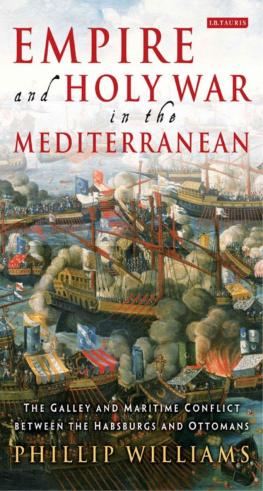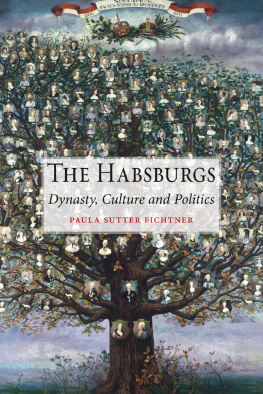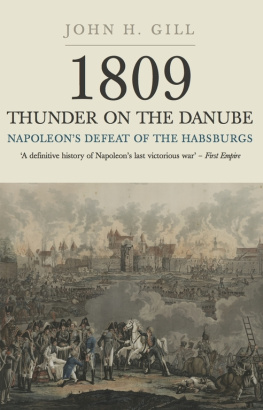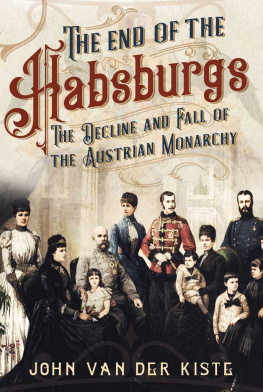The Dynasties
Series Editor: Nigel Saul, Professor of Medieval History Royal Holloway, University of London, UK
Also in the series:
The Tudors, David Loades (2012)
The Plantagenets, Jeffrey Hamilton (2010)
The Romanovs, Lindsey Hughes (2009)
The Valois, Robert Knecht (2007)
The Capetians, Jim Bradbury (2007)
The Yorkists, Anne Crawford (2007)
The Bourbons, J. H. Shennan (2007)
The Hanoverians, Jeremy Black (2006)
The Normans, David Crouch (2006)
The Bonapartes, William H. C. Smith (2006)
The Stuarts, John Miller (2006)
The Habsburgs
The History of a Dynasty
BENJAMIN CURTIS

Bloomsbury Academic
An imprint of Bloomsbury Publishing Plc
50 Bedford Square London WC1B 3DP UK
1385 Broadway New York NY 10010 USA
www.bloomsbury.com
First published 2013
Benjamin Curtis, 2013
All rights reserved. No part of this publication may be reproduced or transmitted in any form or by any means, electronic or mechanical, including photocopying, recording, or any information storage or retrieval system, without prior permission in writing from the publishers.
Benjamin Curtis has asserted his right under the Copyright, Designs and Patents Act, 1988, to be identified as Author of this work.
No responsibility for loss caused to any individual or organization acting on or refraining from action as a result of the material in this publication can be accepted by Bloomsbury Academic or the author.
Every reasonable effort has been made to trace copyright holders of material reproduced in this book, but if any have been inadvertently overlooked the Publishers would be glad to hear from them.
British Library Cataloguing-in-Publication Data
A catalogue record for this book is available from the British Library.
eISBN: 978-1-4411-0053-5
CONTENTS
Cover: Maximilian I and family, by Bernhard Strigel (after 1515). In the collection of the Kunsthistorisches Museum, Vienna. Image courtesy of the Bridgeman Art Library.
Figures
Maps by C. James Carter
Table


There is no shortage of books about the Habsburgs. That is only fitting for the family that can stake a credible claim to being the most important in European history. However, English has long lacked a concise overview of the dynasty, covering its first king to its last, and embracing both the Spanish and the Austrian branches of the family. This book seeks to fill that gap by answering some of the basic questionsWho were these people? What did they do?while always keeping the dynasty itself at the center of the analysis. It was a family business, after all, whose individual members should be seen in the context of both their predecessors and successors. The task is to understand how the dynasty worked as a unit, and did so in a way that elevated it to the first rank of European royal houses. In surveying such broad territory chronologically and geographically, I hope that I have not sacrificed scholarly rigor in my attempt to make the narrative at least somewhat accessible to and engaging for nonspecialists. Contemporary academia tends to reward the narrow rather than the broad. But sometimes the educational mission demands a breadth comparable to the Habsburgs own expansive ambit.
Like any book, this one required the hard work of many people besides my own. The staff at Seattle Universitys Lemieux Library were outstanding in fetching material from far and near for the long research process. I am grateful to my colleagues in Matteo Ricci College for providing a worthy intellectual home. In particular, I cannot thank Dan Doyle, Emily Lieb, and Daniel Washburn enough for their comments on the manuscript. Thanks also to the other anonymous readers, and to Nigel Saul, the series editor, who provided feedback. All inadequacies are solely mine, as the standard disclaimer goes. My old friend Christopher Carter did excellent work on the maps. Rick Steves, Steve Smith, Michelle Michael Kono, and many other estimable compatriots in Edmonds have made it possible for me to go teach and learn in central and eastern Europe every year. Claire Lipscomb and Rhodri Mogford at Continuum-Bloomsbury were invaluable editors throughout this process. To these people and many others, for their support over the years of writing this book, Danke, gracias, ksznm, dkuji, merci, obrigado, dzkuj, hvala, grazie, mulumescin only some of the many languages of the Habsburg domains.
AEIOU. The vowels themselves symbolized the Habsburg destiny: Austriae est imperare orbi universo (Austria is to rule the whole world). Another version of the motto was Alles Erdreich ist sterreich untertan (All the world is subject to Austria). This rather audacious usurpation of the alphabet was quite characteristic of the ambitionand the confidenceof the House of Habsburg. The familys members were sure that they were born to rule. And though they shared this ideology of divine right with other European dynasties, several things make the Habsburgs distinct from the rest. Their preeminence was longer lasting, and their ambitions more grandiose, than any other modern royal family. For almost 650 years, from 1273 to 1918, Habsburg sons (and even a few daughters) ruled lands at the heart of Europe. There are only a few current countries on the continent whose lands were not at one point ruled by a Habsburg. From England to Serbia, Portugal to Poland, in the early modern period the dynastys dominions extended still further, encompassing nearly all of the Americas, touching territories in Africa and Asia as well. Not content with their near-monopoly of the highest crown in the West, that of the Holy Roman Empire, Habsburg rulers up to the eighteenth century truly believed that it was their destiny to rule the universal orb, to govern as much of the globe as possible.
The AEIOU motto is but one example of how the Habsburgs wove a mythology of glory about themselves. They concocted genealogies to make their ancestors Roman nobles and Trojan heroes. They built lasting architectural monuments to their own majesty, such as the great palaces of Schnbrunn outside Vienna or El Escorial outside Madrid. They assembled a legendary treasury, now in the Viennese Hofburg, to show off the familys fabulous wealth. It holds objects such as the Holy Lance that supposedly pierced Christs side, and the garishly bejeweled crown of the Holy Roman Emperor, once believed to have sat on the head of Charlemagne himself. They commissioned the greatest artists of their day such as Drer, Titian, and Velzquez to create regal portraits of Habsburg family members. These paintings, and much other art besides, gave rise to the incomparable collections of the Museo del Prado in Madrid and the Kunsthistorisches Museum in Vienna, which also serve as enduring reminders of Habsburg refinement.
Such practices were not uncommon among European dynasties. But where the Habsburgs are again distinct is that no other dynasty has so thoroughly penetrated the popular imagination. The Habsburgs reputation among the general public includes elements rather more dubious than those many old emperors would prefer. Another of the Houses celebrated mottosLet others wage war; you, happy Austria, marryis often inextricably associated with tales of the familys inbreeding. Those marital connections were indeed for a long time tightly linked within the family, which did produce a rather watery genetic stew, incarnated above all in the disabled Carlos II, the dead end of the Spanish Habsburgs. The marriage policies also perpetuated the familys most characteristic physical inheritance: the protuberant jaw known as the Habsburg lip, easily visible in many of those same regal portraits by the great artists.
Next page










